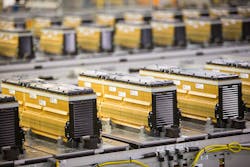Cree Strikes Deal with GM for Silicon Carbide Chips, Changes Name
Cree said that it hammered out a deal with General Motors to supply the auto giant with silicon carbide (SiC) chips for future electric vehicles, giving it an important win as the sector's EV ambitions shift into high gear.
The company also said that it has officially changed its name to Wolfspeed to reflect its transformation into a power semiconductor maker. Cree was previously a leading player in LEDs, but it refocused on chips last year.
Specifically, the silicon carbide chips will be used in integrated power electronics in GM's proprietary Ultium Drive system, which will be used in the firm's future electric vehicles, the companies said. Power electronics that convert one voltage level to another are at the heart of many parts of the EV, such as onboard chargers, inverters, and other parts of the powertrain that takes power stored in a battery and delivers it to the wheels.
Silicon carbide chips have unique physical properties that allow them to squeeze more power into a smaller envelope that weighs less and emits less heat, so electric cars can travel farther on a charge. “Customers of EVs are looking for greater range, and we see silicon carbide as an essential material in the design of our power electronics to meet customer demand," said GM supply chain and global purchasing VP Shilpan Amin.
The terms of the deal were not announced.
Tesla was one of the early converts to silicon carbide, using the material in the onboard charger and many of the inverters in its EVs. Other companies are following in its footsteps. To handle the huge amounts of power moving throughout the cars, companies are moving to architectures that can handle 400-V to 800-V to boost range per charge and faster charging. The ability to safely handle higher voltages is why silicon carbide is key.
Silicon carbide is aso-called wide-bandgap semiconductor, a property that helps it withstand higher voltages and handle higher temperatures than silicon. The chips are used as electronic switches that distribute power through the powertrain in a way that limits losses in the EV. They also have lower resistance, which means a SiC transistor or diode loses less power to heat, opening the door to smaller heat sinks and cooling systems.
Along with the ability to tolerate high voltages, the chips also run at higher frequencies and more efficiently without the unwanted losses of insulated-gate bipolar transistors (IGBTs) and MOSFETs that dominate EVs.
For all its advantages, silicon carbide is a very challenging material to master. The process starts by growing ingots of raw silicon carbide called boules in special furnaces that keep the material very pure. Contaminants can destroy the properties companies want out of the chips and hurt yields. Silicon carbide is also very hard and brittle, and it requires special tools to carefully cut wafers out of the boule without any defects.
The raw wafers also have to be polished perfectly smooth before being processed to reduce flaws.
The result is that silicon carbide chips are relatively expensive compared to silicon chips used in current EVs. According to Yole Développement, SiC modules cost around three times more than high-voltage IGBTs today.
Wolfspeed has worked with silicon carbide for three decades. On top of developing silicon carbide chips and other devices internally, it outputs around 60% of the world's raw silicon carbide material. It has signed supply deals with many of its competitors, including STMicroelectronics, Onsemi, and Infineon Technologies that use the raw wafers to fabricate chips. Wolfspeed is expanding its output to fill the growing demand.
The silicon carbide chips Wolfspeed is supplying to GM will be made at its fab in upstate New York, which will be the largest silicon-carbide fab in the world when completed. Wolfspeed said the new production plant will make chips on 200-mm wafers. Upgrading from 150-mm to 200-mm wafers roughly doubles the number of chips it can slice out of a wafer. That will help expand the company's output and drive down chip prices.
Wolfspeed said the fab will start mass production in early 2022. The company said the supply deal will give give GM a secure, long-term, and domestic supply of automotive-grade chips for high-voltage systems.
Every EV powertrain contains several major building blocks-and silicon carbide is targeting many of them.
The onboard charger, or OBC, converts alternating current (ac) from the power grid to direct current (dc) and then uses it to charge the battery pack. The traction inverter is at the heart of the powertrain, which converts electricity to propel the electric motor rotating the wheels. The dc-dc converter steps down voltages from the battery to control headlights, side mirrors, power windows and other electronics that require lighter loads.
For years, car manufacturers rarely purchased chips directly from vendors—or even interacted with them at all. But with widespread shortages of auto chips in recent months, many are overhauling their supply chains and striking supply deals with semiconductor firms to lock in supply over the long term. GM, Ford, and other industry giants are also sharing more transparent forecasts with chip vendors to help with capacity planning.
The GM partnership plays directly into that strategy, Wolfspeed CEO Gregg Lowe said. “This agreement ensures long-term supply of silicon carbide to GM to help them deliver on their promise of an all-electric future."
About the Author
James Morra
Senior Editor
James Morra is the senior editor for Electronic Design, covering the semiconductor industry and new technology trends, with a focus on power electronics and power management. He also reports on the business behind electrical engineering, including the electronics supply chain. He joined Electronic Design in 2015 and is based in Chicago, Illinois.

